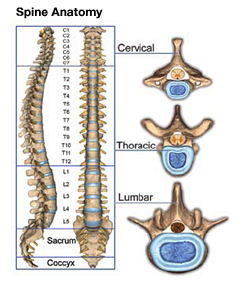Spinal Disorders
 Description of Disorders
Description of Disorders
Degenerative Disc Disease
Aging and/or traumatic wearing away of the
discs (shock absorbers) that are located between
the spinal vertebrae (bones).
Degenerative Spinal Arthritis
Aging phenomenon gives rise to a wearing away
of the smooth cartilage (Teflon coating) within
the spinal facets (joints).
Sciatica
Pain, numbness, tingling or weakness in one or
both legs referable to inflammation or
compression of one or more branches of the
sciatic nerve (nerve symptoms).
Herniated Disc
Rupture of a piece of the disc, sometimes causing
pressure on a nerve or the spinal cord, with
resulting pain, numbness or weakness in one
or both arms or legs (nerve symptoms).
Stenosis
Narrowing of an area in the spinal canal which
may cause "nerve symptoms" if the narrowing
compresses a nerve.
Spondylolisthesis
Slippage of one vertebral body on another due to
either aging arthritis or to a fracture, acquired
during childhood or adolescence. Slippage and
instability may cause nerve symptoms.
Scoliosis
Curvature of the spine usually due to congenital,
unknown or degenerative causes.
Osteoporosis
Loss of calcium from spinal bones. Most
commonly occurring in older women after
menopause.
Fractures
Spinal bones typically fracture due to trauma
and falls, although they may occur in osteoporosis
patients with minimal if any trauma.
Tumors
Tumors may be benign or malignant. Although
they may arise primarily from the spinal vertebrae
themselves, these bones are frequently the site of
secondary deposition of malignant tumors arising
from other organs (metastasis lesions).
Infections
The spinal bones and discs may become infected,
usually from bacteria traveling in the blood or
urine.
Possible Treatment Options
Treatment
Degenerative disc disease, spinal arthritis, sciatica, herniated
disc, stenosis and spondylolisthesis are usually treated initially
with pain medications, physical therapy and spinal cortisone
injections. When these treatments fail, surgery, in the form of
nerve decompression with or without spinal fusion, may be
indicated.
Scoliosis
Children's and teenage scoliosis are treated with observation,
bracing, or surgery.
Adult scoliosis is usually treated with medication, physical
therapy and spinal cortisone injections for pain. Progressive
curves can be treated surgically.
Osteoporosis is treated with medications. Fractures are treated with rest, bracing or surgery.
Tumors are treated with radiation, chemotherapy and
sometimes surgery.
Infections are treated with antibiotics and sometimes surgery.
For more information on Spinal Disorders, visit UnderstandSpineSurgery.com.
